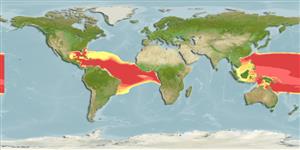>
Argentiniformes (Marine smelts) >
Microstomatidae (Pencil smelts)
Etymology: Xenophthalmichthys: Greek, xenos = strange + Greek, ophthalmos = eye + Greek, ichthys = fish (Ref. 45335).
Eponymy: The succession of Danish research vessels named ‘Dana’ seem to have been greatly favoured by describers of fish, and often the etymology includes: “…from which the holotype was collected. [...] (Ref. 128868), visit book page.
More on author: Regan.
Environment: milieu / climate zone / depth range / distribution range
पारिस्थितिकी
समुद्री; गहराई सीमा 0 - 1250 m (Ref. 58018). Tropical
Eastern Atlantic: taken at two off-shore localities. Western Atlantic: 14°N 61°40'W. Western Pacific: Java Trench area - 10°18'S 110°23'E. Probably circumtropical.
आकार / वज़न / Age
Maturity: Lm ? range ? - ? cm
Max length : 10.0 cm SL पुल्लिंग / अलिंग; (Ref. 4458)
Short description
पहचान कुंजी | आकृति विज्ञान | मौरफोमैटरिक्स
Slender fish. Swim bladder not observed (Ref. 37473).
Life cycle and mating behavior
परिपक्व अवधि | पुनरुत्पत्ति | मछलीऔ का अंडे देना | अंडे | Fecundity | लार्वा
Cohen, D.M., 1990. Argentinidae. p. 235-238. In J.C. Quero, J.C. Hureau, C. Karrer, A. Post and L. Saldanha (eds.) Check-list of the fishes of the eastern tropical Atlantic (CLOFETA). JNICT, Lisbon; SEI, Paris; and UNESCO, Paris. Vol. 1. (Ref. 4458)
IUCN Red List Status (Ref. 130435: Version 2024-1)
Threat to humans
Harmless
Human uses
साधन
Special reports
Download XML
इंटरनेट स्रोत
Estimates based on models
Preferred temperature (Ref.
123201): 8.3 - 20.1, mean 13 °C (based on 426 cells).
Phylogenetic diversity index (Ref.
82804): PD
50 = 1.0000 [Uniqueness, from 0.5 = low to 2.0 = high].
Bayesian length-weight: a=0.00389 (0.00180 - 0.00842), b=3.12 (2.94 - 3.30), in cm total length, based on all LWR estimates for this body shape (Ref.
93245).
Trophic level (Ref.
69278): 3.2 ±0.4 se; based on size and trophs of closest relatives
Fishing Vulnerability (Ref.
59153): Low vulnerability (10 of 100).
